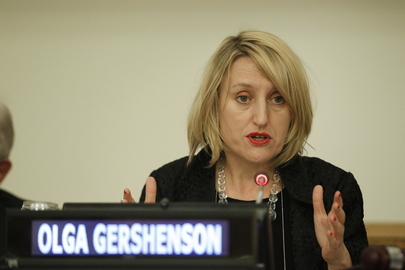Learning about the Holocaust through the Arts
(28 April 2014)
Artists and academics joined in a panel discussion at UN Headquarters, which explored Holocaust education through dance, literature, music and film. Developed in the context of a new educational approach with the goal of reaching out to a broader audience, the event, organized by the Department of Public Information, in partnership with the Permanent Mission of Israel to the United Nations and the World Jewish Congress, brought together students of the various art forms from over 30 schools and universities.


Peter Launsky-Tieffenthal, Under-Secretary-General for Communications and Public Information,
makes opening remarks. UN Photo/Paulo Filgueiras
“Incorporating the arts in teaching about the Holocaust helps us to further personalise stories and appeal to all of our senses”, said Under-Secretary-General Launsky-Tieffenthal in his opening remarks. This power of art in communicating a story was introduced with a presentation of the ballet “Light/The Holocaust and Humanity Project”, which Stephen Mills, Artistic Director for Ballet Austin, wrote in the aftermath of 9/11. He based it on the life of Holocaust survivor Naomi Warren, who joined him in the presentation. “You can have a very wealthy life, but all those things can disappear. But what you have learned always will guide you,” said Mrs. Warren, who survived three different Nazi concentration camps.

Holocaust survivor Naomi Warren. UN Photo/Paulo Filgueiras
Israeli author Nava Semel spoke about how literature was cathartic for her in learning about the traumatic experience endured by her Holocaust survivor parents. She explained how her family avoided talking about their experience in order to protect each other. She sees art as a way of “sending an emotional message into the future” that can move the heart, mind and spirit, and help develop “responsible human beings”. This powerful message is the leitmotif of her book “And the Rat Laughed”, which was brought to life by Academy award-winning actress Olympia Dukakis.
Olga Gershenson, Associate Professor at the University of Massachusetts, Amherst presented films that had been banned or had disappeared during the Holocaust. She explained how “Professor Mamlock” succeeded in educating Soviet Jews about Hitler before the 1939 "Nazi-Soviet Non-Aggression Pact" between Hitler and Stalin. People who saw the film, she said “knew not to trust the Soviet propaganda… and escaped and were saved. People who remained in their home towns were murdered right there.”

Olga Gershenson, Associate Professor of Judaic and Near Eastern Studies
at the University of Massachusetts. UN Photo/Paulo Filgueiras
Clive Marks and Professor Shirli Gilbert concluded the evening by speaking about the power of music as an educational tool, and presented the ORT “Music and the Holocaust” website which stores a database of music produced, and listened to, by inmates during the Holocaust. “Songs were a means… to make sense of a frightening and ever changing reality”, said Ms. Gilbert. “Songs became a kind of storehouse of the victims’ shared interpretations of what was happening”.
UN News Centre: Music at UN event teaches about the Holocaust through victims' experiences
Press Release: Renowned Artists to Encourage Holocaust Education at United Nations-sponsored Event, 28 April 2014